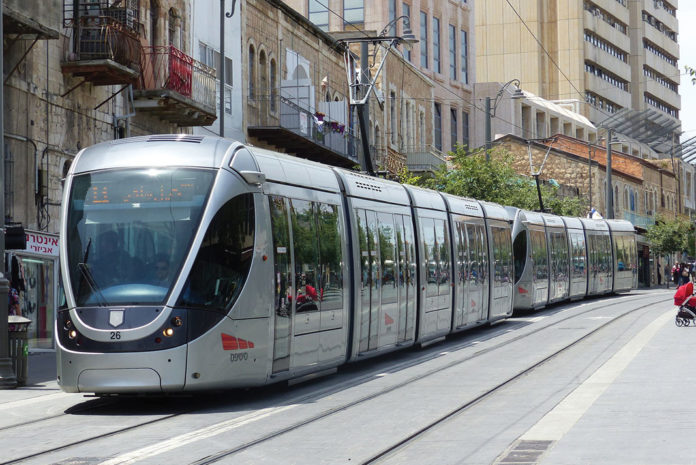By Adam Abrams for JNS.org
Rapid growth in Israel’s population and economy during the past two decades has prompted the Israeli government to revolutionise the country’s infrastructure and transportation systems to accommodate a flourishing citizenry.
The average annual growth rate of Israel’s population from 1990-2017 has been approximately 2.25 percent. This is “among the highest rate of population growth in the Western world,” Prof. Yoram Shiftan, head of transportation research at the Haifa-based Technion — Israel Institute of Technology, told JNS.org. During the same period, Israel’s GDP, the key indicator of a nation’s economic growth, averaged a 4.9 percent annual increase.
These figures are used by Israel’s Ministry of Transportation to project the future transport and infrastructure needs of the Jewish state — decades down the road — and to modify the country’s infrastructure accordingly.
Israel’s above-average economic and demographic advancements are directly reflected by parallel growth in the country’s transport activity, including in the number of vehicles on roads, cargo passing through seaports, passengers traveling through Ben Gurion International Airport and commuters using the railway system.
Due to this growth, the development of Israel’s transport infrastructure became a top government priority during the past decade, and the state’s budget for infrastructure development is gradually increasing.
According to a spokesperson from the Transportation Ministry who asked not to be named, Israel’s budget forecasts for the five-year period from 2020-2025 are projected to be significantly higher than the budget for 2015-2020, largely due to a government commitment to heavily invest in the expansion of mass transit systems via land, water and air.
At the same time, Israel’s prioritisation of transport infrastructure development “is a relatively new trend,” said Technion’s Shiftan, explaining that 15 years ago, “significantly less government funding was allocated… and this created an enormous gap in the public transport infrastructure.”
Land transport
In the 1990s and 2000s, significant government investment was applied to upgrading and widening Israel’s highway network. But in recent years, the Transportation Ministry has started prioritizing the development of the national rail system and mass transit systems in urban areas, while also emphasizing the development of new rail connections in Israel’s peripheral regions.
In 2010, Israeli Transportation Minister Yisrael Katz presented the government with the detailed ‘Netivei Israel’ plan, which aims to establish an inter-city transport network from Israel’s northern Galilee to its southern Negev. Some of the program’s projects are under construction, and others are already operational.
According to the government spokesperson, “Northern cities such as Beit She’an, Afula, Carmiel, Nahariya, Acco and Haifa, and southern cities such as Be’er Sheva, Ofakim, Netivot, Sderot, Ashkelon, Ashdod” will all be connected with the central regions of the country through the national rail network.
When the new train lines are completed, “people who live in places like Ofakim will be able to easily commute to work in Tel Aviv,” said Rick Krosnick, chief development officer for the Jewish National Fund, which works closely with the Israeli government to spur economic development in the peripheral regions of the country.
As a result of the new connectivity, “we will see in the next five years high-tech workers in (urban) Haifa who want to live in an area like (rural/peripheral) Beit She’an,” Krosnick told JNS.org.
One highly anticipated railway project is a high-speed line connecting Jerusalem to Tel Aviv in a trip of less than 30 minutes when it opens in 2018.
In recent years, Israel also began the development of urban mass transit systems, the first of which was Jerusalem’s light rail line. Now, Israel plans to establish mass transit systems and networks in all urban areas. The first line of the Tel Aviv metropolitan area’s light rail system is under construction. The Tel Aviv line and other urban rails are slated for completion between 2020 and 2023.
“Israel must accelerate the implementation of these plans in addition to implementing various policies to reduce single occupancy car travel and encourage public transportation usage, car sharing, cycling and walking,” Shiftan said.
Maritime development
Israel’s primary maritime infrastructure includes main ports in Haifa and Ashdod, and a small privatized port in Eilat. By 2021, “We will see the operation of two new seaports, both in Ashdod and Haifa, alongside the existing ports…this will certainly be an enormous change in terms of the level of capacity and efficiency,” the Transportation Ministry spokesperson said.
It is also anticipated the existing government-owned ports in Ashdod and Haifa will be privatized, with the goal of encouraging competition and creating efficiency.
Airports
Twelve miles from Israel’s southern city of Eilat, the country’s first ‘green field’ airport is set for completion later this year.
Ben Gurion International Airport has seen significant investment applied to improving its infrastructure to accommodate increased air traffic to Israel, a trend spurred by the recently implemented ‘Open Skies’ agreement between Israel and the European Union. In recent years, Ben Gurion has received upgraded runways, a new control tower and a new security system.
There are also future plans to develop a new airport “in the north of the country” through private sector investment, according to the transportation spokesman.
Future trends
Additional transportation projects in Israel include a light rail system connecting Haifa and Nazareth, two additional rail lines in Jerusalem, two additional fast lanes for Tel Aviv’s highways, a new 39-mile double track eastern railway running parallel to the cross-Israel highway (Highway 6) and a national plan for smart mobility.
“Israel, as a major start-up nation,” said Shiftan, “is one of the major contributors to driverless automated car technology… We expect to see driverless cars on our street in the future…Israel must prepare appropriate policies and infrastructure for this era.”











